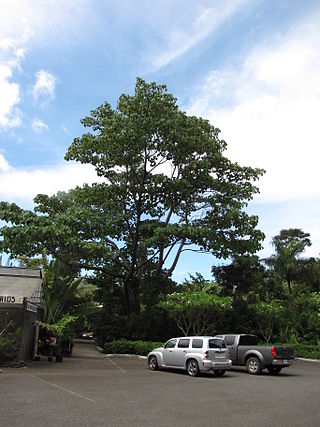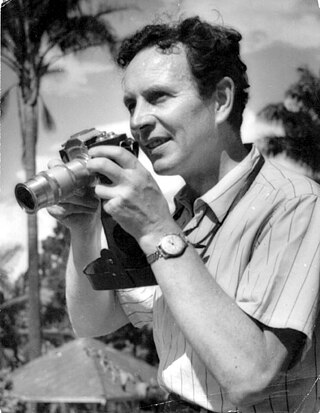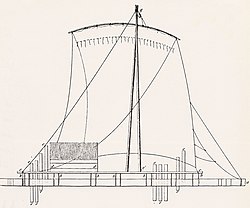
Thor Heyerdahl KStJ was a Norwegian adventurer and ethnographer with a background in biology with specialization in zoology, botany and geography.

Ochroma pyramidale, commonly known as the balsa tree, is a large, fast-growing tree native to the Americas. It is the sole member of the genus Ochroma. The tree is famous for its wide usage in woodworking, due to its softness and its high strength compared to its low density. The name balsa is the Spanish word for "raft."

A raft is any flat structure for support or transportation over water. It is usually of basic design, characterized by the absence of a hull. Rafts are usually kept afloat by using any combination of buoyant materials such as wood, sealed barrels, or inflated air chambers, and are typically not propelled by an engine. Rafts are an ancient mode of transport; naturally-occurring rafts such as entwined vegetation and pieces of wood have been used to traverse water since the dawn of humanity.

The Kon-Tiki expedition was a 1947 journey by raft across the Pacific Ocean from South America to the Polynesian islands, led by Norwegian explorer and writer Thor Heyerdahl. The raft was named Kon-Tiki after the Inca god Viracocha, for whom "Kon-Tiki" was said to be an old name. Heyerdal’s book on the expedition was entitled The Kon-Tiki Expedition: By Raft Across the South Seas. A 1950 documentary film won the Academy Award for Best Documentary Feature. A 2012 dramatized feature film was nominated for the Academy Award for Best Foreign Language Film.


The emergence of metallurgy in pre-Columbian Mesoamerica occurred relatively late in the region's history, with distinctive works of metal apparent in West Mexico by roughly 800 CE, and perhaps as early as 600 CE. Metallurgical techniques likely diffused northward from regions in Central or South America via maritime trade routes; recipients of these metallurgical technologies apparently exploited a wide range of material, including alloys of copper-silver, copper-arsenic, copper-tin and copper-arsenic-tin.

Eduard Ingriš was a Czech-American composer, photographer, conductor and adventurer.

The Tangaroa Expedition of 2006 closely resembled the Kon-Tiki expedition sailing a balsa raft from Peru to Polynesia. Tangaroa outperformed Kon-Tiki by having an improved sail rig and by actively using guaras (centerboards). As such, the expedition represents a scientific continuation of Thor Heyerdahl's experiments in recreated maritime technology.
The Kantuta Expeditions were two separate expeditions on balsa rafts led by the Czech explorer and adventurer Eduard Ingris.

William Willis was an American sailor and writer who is famous due to his solo rafting expeditions across oceans.

The Kon-Tiki Museum is a museum in the Bygdøy peninsula in Oslo, Norway. It houses vessels and maps from the Kon-Tiki expedition, as well as a library with about 8,000 books. It was opened in a provisional building in 1949. In 1957, the current building—designed by architects F. S. Platou and Otto Torgersen—was opened. In 1978, an extension of the museum designed by Torgersen was opened.
Vital Alsar Ramírez was a sailor and scientist who made several extremely long sailing expeditions. His entire life was linked to nature and the sea. He became professor of economics, although he never acted as such.

Reed boats and rafts, along with dugout canoes and other rafts, are among the oldest known types of boats. Often used as traditional fishing boats, they are still used in a few places around the world, though they have generally been replaced with planked boats. Reed boats can be distinguished from reed rafts, since reed boats are usually waterproofed with some form of tar. As well as boats and rafts, small floating islands have also been constructed from reeds.

Axe-monies refer to bronze artifacts found in both western Mesoamerica and the northern Andes. Based on ethnohistorical, archaeological, chemical, and metallurgical analyses, the scholars Hosler, Lechtman and Holm have argued for their use in both regions through trade. In contrast to naipes, bow-tie- or card-shaped metal objects which appear in the archaeological record only in the northern Andean coastal region, axe-monies are found in both Mesoamerican and Andean cultural zones. More specifically, it is argued that the system of money first arose on the north coast of Peru and Ecuador in the early second millennium CE. In both regions, bronze was smelted, likely by family units, and hammered into thin, axe-shaped forms and bundled in multiples of five, usually twenty. As they are often found in burials, it is likely that in addition to their presumed economic use, they also had ceremonial value.

Kon-Tiki is a 2012 historical drama film directed by Joachim Rønning and Espen Sandberg about the 1947 Kon-Tiki expedition. The film was mainly shot on the island of Malta. The role of Thor Heyerdahl is played by Pål Sverre Hagen. The film is an international co-production between Norway, Denmark, Germany, Sweden, and the United Kingdom.

Torgeir Sæverud Higraff is an explorer, teacher and author with special interest in prehistoric transoceanic contact. Like Thor Heyerdahl, Higraff combines history, anthropology and traditional knowledge with expeditions. In 2002, the year Heyerdahl died, Higraff decided to recreate the Kon-Tiki expedition, and in 2006 the Tangaroa Expedition sailed from Peru to Raiatea in eastern Polynesia. Tangaroa outperformed Kon-Tiki by using an improved sail rig and active use of the guara centerboards.
A guara is a hardwood centerboard used in Andean rafts. The Tangaroa Expedition outperformed Kon-Tiki in part due to using guaras.

Between 1966 and 1973, Spanish explorer Vital Alsar led three expeditions to cross the Pacific Ocean by raft – La Pacífica in 1966, La Balsa in 1970 and Las Balsas in 1973. Travelling from Ecuador, South America, to Australia, the first expedition failed, but the second and third succeeded, both setting the record for the longest known raft voyages in history – 8,600 miles (13,800 km) and 9,000 miles (14,000 km) respectively.

The Kon-Tiki2 Expedition built and sailed two balsawood rafts from Peru to Easter Island in 2015. The goal of the expedition was to show that balsawood rafts can be sailed across long distances, and to collect scientific data in the southeast Pacific. The expedition built two rafts in 30 days and went on to sail the rafts more than 2000 nautical miles before reaching Easter Island after 43 days at sea. No other balsa rafts have sailed to Easter Island in modern times.

Abora is the name of several reed boats built by the German explorer Dominique Görlitz. The expeditions were inspired by previous trans-oceanic expeditions by the Norwegian explorer Thor Heyerdahl. Main aim of the Abora expeditions was to prove that a keel-less reed boat could be steered crosswise and against prevailing winds, using sideboards (leeboards) in lieu of a fixed keel. The name of the vessels was derived from the Canarian deity Abora.



















